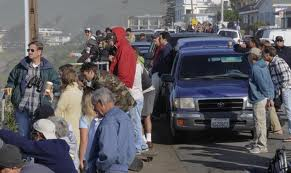题目内容
WELLINGTON, September 19 (Xinhua) -- If your teenage son won't get out of bed in the morning, then take comfort from the fact that he might be sleeping his way to a healthier future, according to a new research from New Zealand.
Researchers in human nutrition at the University of Otago have found that teenage boys who sleep less have more body fat when compared to girls, for whom lack of sleep has no noticeable effect on their body fat ratios.
The study of 386 boys and 299 girls aged 15 to 18 found that average-sized 16-year-old boy weighing 69.5 kg and 176 cm tall, who slept for eight hours a day, had a waist size l.8 cm bigger and l.6 kg, or 9 percent, more body fat than the average-sized boy who slept 10 hours a day.
"The boys who slept eight hours a day would also have l.8 kg more lean (bone and muscle) mass compared to the boys who slept 10 hours, but that's only a 1.4-percent increase, compared to the 9- percent increase seen in body fat," said lead researcher from the Department of Human Nutrition, Dr. Paula Skidmore.
"Our results suggest that for older teenage boys, making sure that they get enough sleep may help to maintain a healthier body. It seems to be that, within reason, the more sleep the better for boys," Skidmore said in a statement Thursday.
"It was unexpected that we did not find the same result in girls, who may actually be more aware of their diet and more in tune with a healthier lifestyle."
The researchers ruled out the effects of food choice and number of screens, such as televisions, games and consoles, which the teenagers had in their bedrooms.
1.What's the research really about?
A. Boys and girls. B. Food and weight. C. Sleep and health. D. Screens and fat.
2.What's the result of less sleep for teenage boys?
A. Bigger waist and more fat in the body.
B. An increase in weight and height.
C. More concerned with their diet.
D. A decrease in bone and muscle.
3.From the sixth paragraph we can infer that ______.
A. girls usually sleep less and have healthier lifestyles than boys
B. the researchers expected to see the same result in girls
C. peoples' diet has a great effect on their health
D. boys are usually lazier than girls
4.Who would be the most pleased to hear the news?
A. Teachers. B. Girls. C. Parents. . D. Boys.
1.C
2.A
3.B
4.D
【解析】
试题解析:本文是一项对青少年的关于睡眠与健康的关系的调查,结果是:睡眠越多越健康(只适合于男孩子)
1.C归纳总结题。根据第一段WELLINGTON, September 19 (Xinhua) -- If your teenage son won't get out of bed in the morning, then take comfort from the fact that he might be sleeping his way to a healthier future, according to a new research from New Zealand. 惠灵顿,九月十九日(新华社)——如果你十几岁的儿子在早晨不起床,那么你将得到安慰,根据这个事实他可能正在睡觉以预示着有着将来更加健康的方式睡觉,根据来自新西兰的一项新的研究,所以C正确。
2.A细节理解题。根据第三段内容The study of 386 boys and 299 girls aged 15 to 18 found that average-sized 16-year-old boy weighing 69.5 kg and 176 cm tall, who slept for eight hours a day, had a waist size l.8 cm bigger and l.6 kg, or 9 percent, more body fat than the average-sized boy who slept 10 hours a day.
可知一天睡八个小时的男孩子和睡十个小时的男孩子作比较,腰围更宽,体重更大,所以A正确。
3.B推理判断题,根据第六段It was unexpected that we did not find the same result in girls我们没有在女孩身上看到同样的结果,这是没有预料到的,可以推断出B正确。
4.D推理判断题。通读全文可以知道调查研究的结果是:男孩子睡得多反而更加健康,而女孩子却没有这样的结果,所以D正确。
考点:考查生活百科类短文阅读。

 名校名师培优作业本加核心试卷系列答案
名校名师培优作业本加核心试卷系列答案 全程金卷系列答案
全程金卷系列答案Tsunami warning system is tested
If he, the founder of the Hawaiian Volcano Observatory, were alive, Thomas Jaggar would be proud of the U.S. tsunami warning system after Friday’s devastating earthquake in Japan sent a surge (大浪,汹涌) of ocean water dashing toward the West Coast.
● WASHINGTON — So many people surged to the West Coast and Alaska Tsunami Warning Center website that it slowed to a crawl early Friday, unable to provide critical information to the public about the coastal impact in the U.S. of a massive earthquake in Japan.
McClatchy Washington Bureau — Mar 11 06:09 p.m.
● CHICAGO — A tsunami warning has been issued for the central and northern California coast and Oregon, the National Weather Service announced early Friday.
Chicago Tribune— Mar 11 06:07 a.m.
● HONOLULU — A tsunami warning was issued late on Thursday for Hawaii after an 8.9 magnitude earthquake struck in the Pacific near Japan, prompting state civil defense officials to order all coastal areas evacuated(把…撤出…)by 2 a.m. local time. Tsunami sirens (警报) began sounding at 9:59 p.m. on Thursday. They have sounded every hour since 11:15 p.m.
Alaska Tsunami Warning Center also issued a warning for much of the coasts of Alaska, Washington, Oregon and California.
Reuters via Yahoo! News — Mar 11 01:22 a.m.
● LOMPOC — Tsunami warning ‘a wake-up call’
A tsunami warning that led to evacuations for coastal 
communities and campgrounds in Santa Barbara and San Luis Obispo counties Friday served as a successful trial for a more serious emergency, officials said after the danger passed.
The Lompoc Record — Mar 11 11:29 p.m.
● WELLINGTON — The Pacific Tsunami Warning Centre issued a warning after an 8.9 magnitude earthquake struck in the Pacific near Japan, and it said the sea level readings confirm that a tsunami has been generated and was in effect for some Pacific islands — Hawaii, China’s Taiwan, the Philippines and Indonesia etc.
New Straits Times — Mar 11 07:48 a.m.
— Reproduced by Yahoo Greenwich Meantime
【小题1】.
. A tsunami warning was issued for all the following states in the U.S. except for _____.
| A.Ohio | B.California | C.Oregon | D.Alaska |
The underlined word “prompting” (in the fourth paragraph) most probably means _____.
| A.promoting | B.advocating | C.urging | D.appealing |
According to the passage, the Pacific Tsunami warning was first reported by _____.
| A.New Straits Times | B.Reuters via Yahoo! News |
| C.McClatchy Washington Bureau | D.Chicago Tribune |
In which city did the news agency issue a tsunami affecting for some other places apart from Japan and Hawaii?
A. LOMPOC. B. WASHINGTON. C. HONOLULU. D. WELLINGTON.
New Zealand
|
What can you see? Mountains, volcanoes, rivers, lakes, waterfalls, forests, beaches. Both islands are mountainous. In fact, only 30% of New Zealand is flat. |
|
The Maoris When the Maoris first arrived in New Zealand, they lived in villages and were excellent fishermen, hunters and farmers. About 50 years ago many Maoris started to live and work in the large cities and took jobs in government, industries, medicine and education. They are proud of their culture and are determined to keep many of the customs which are part of their way of life. |
|
Who can you meet? Most people live on North Island. Eighty-five percent of New Zealanders are “pakeha” (“white men”), which means their “great grandfathers” came from Europe. Ten percent are Maoris. The Maoris came to New Zealand from the Polynesian islands probably around the tenth century. The “pakeha” started to arrive in New Zealand from Europe about 200 years ago as farmers and traders. |
|
Fact box: New Zealand Position: South of the Equator (赤道); nearest neighbour: Australia, 1600 km away. Size: Two main islands — North Island and South Island: together they are 268.680 sq. km. Population: 4 million Capital: Wellington Languages: English and Maori |
1. Which of the following is a fact about New Zealand?
A. 20% of the population being Maoris. B. Four million white people.
C. About 1600 km south of the Equator. D. Nearly 1/3 of the country being plains(平原).
2. The country’s population is mainly made up of .
A. the white people and the Polynesians B. the white people and the “pakeha”
C. the Maoris and the white people D. the Maoris and the Polynesians
3. When did the white people begin to live in New Zealand?
A. 1000 years ago. B. 200 years ago.
C. 85 years ago. D. 50 years ago.
4. What do the Maoris value most in life?
A. Living in small villages. B. Developing farming skills.
C. Keeping their own culture. D. Taking up government jobs.